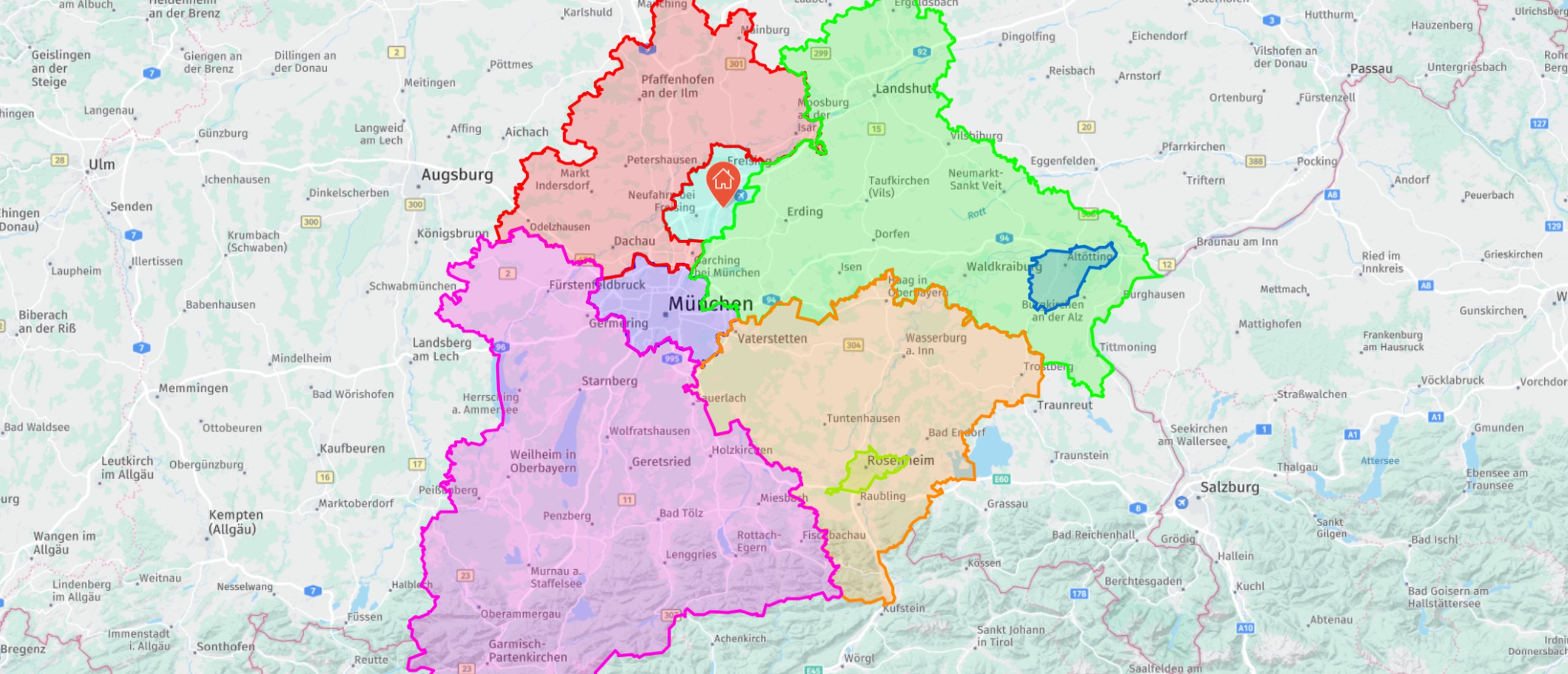In the dispatching of groupage freight forwarders, operations have traditionally been organized using territories. In local transport, this refers to clearly defined delivery areas, usually structured by postal code zones (“Territory 1, Territory 2 …”). This model has proven its worth for decades because it reduces complexity and provides stability. At the same time, however, it also brings certain drawbacks.
The crucial question today is: Are these territories still up to date – or do they now hold companies back more than they help?
Why freight forwarders work with territories
Territories have long been the backbone of many groupage networks for several reasons. On the one hand, many tours are handled through subcontractor agreements that require fixed allocations. On the other, territories increase driver satisfaction: those who repeatedly serve “their” area know the roads and customers, feel more comfortable, and identify more strongly with their work.
From a customer perspective, territories also bring advantages. Regular drivers know the contacts, ramps, and specific requirements on site. This ensures faster processing, better service quality, and stronger customer loyalty. For dispatchers, territories mean less complexity: instead of reordering the entire delivery area every day, a large problem is broken down into several smaller ones. In the extreme, what remains is only sequencing within a given territory.
The advantages of territories
From a freight forwarder’s point of view, territories have tangible benefits:
- Reduced complexity: dispatchers can focus on clearly defined planning zones.
- Shorter stop times through routine: drivers save time because they know processes and contacts.
- Service quality and long-term relationships: customers feel well looked after by their regular drivers.
- Driver retention: having “their own” territory increases satisfaction and loyalty.
The disadvantages of territories
The downside can be significant. Artificially set boundaries may prevent tours from being planned optimally and from realizing their full potential.
Typical disadvantages include:
- Limited optimization potential: fixed borders prevent free and optimal combinations.
- Outdated territories: many were defined years ago and no longer reflect today’s shipment volumes or customer structures.
- Lack of flexibility: short-term volume fluctuations or sick leave are hard to absorb.
- Path dependency: drivers often resist giving up their territories, even when a change would make sense.
- Restricted local knowledge: drivers who only know “their” territory need more time when covering for others.
When are territories useful?
Territories are neither inherently good nor bad. They are a tool that is useful in some situations – and a hindrance in others.
They make sense when service quality and stability are the priority, when shipment volumes remain relatively constant, or when subcontractor agreements prescribe fixed areas. They are also practical when dispatching has to work quickly and manually, and hall processes do not allow for flexible routing.
They become problematic when flexibility is critical – for example, in the face of fluctuating volumes, acute driver shortages, or increasing pressure to reduce costs and CO₂ emissions.
Three scenarios on How territories can be redefined with modern route planning
Many groupage freight forwarders still operate with fixed territories. Drivers serve familiar areas, dispatchers plan within set boundaries. However, with the use of modern route planning software, new possibilities open up: structures can be redesigned, scenarios tested, and optimization potential revealed.
Essentially, there are three options:
1. Small territories: Stability with monitoring effort
Keeping established territories reduces complexity and ensures high driver and customer satisfaction. With software, these territories can be regularly reviewed: are the boundaries still appropriate? Do the stops still match actual shipment volumes?
Benefit of route planning software: automated analyses highlight imbalances in workload. Adjustments can then be made selectively and based on data, without questioning the entire structure.
2. Larger territories: The golden middle ground
Combining several smaller territories creates larger planning zones. Drivers remain in familiar regions, but dispatchers gain significantly more flexibility. This makes it easier to balance optimization and service.
Benefit of a route planning software: simulations show how workload, mileage, and driving times change when territories are restructured. This makes it possible to find the “golden middle” that balances service quality and efficiency.
Free planning: Maximum flexibility – but radical
The most radical option: tours are recalculated every day, entirely independent of fixed territories. This allows maximum flexibility and cost efficiency but requires end-to-end digital steering, digital support in the transshipment hall, and a cultural shift in the organization.
Benefit of software: automated optimization evaluates millions of possible combinations in seconds and provides dispatchers with concrete proposals. What was once an unmanageable task becomes a manageable decision-making process.
Conclusion
Whether small territories are maintained, larger ones created, or free planning introduced – the key lies in software support. It makes visible which potentials exist within the current structure and gives dispatchers the confidence to evaluate even radical changes on a solid basis.
Freight forwarders that digitalize their route planning today secure the flexibility to transform their territory model step by step – without taking unnecessary risks. Let’s find out together which scenario offers the greatest value for your business – in a non-binding demo, we’ll show you how Smartlane can support you.
